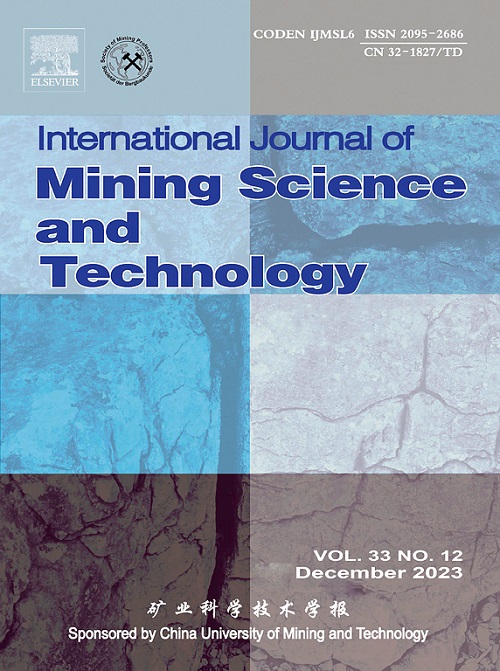煤地下气化环境下煤柱降解机理:承载力、热解行为和孔隙结构
IF 13.7
1区 工程技术
Q1 MINING & MINERAL PROCESSING
International Journal of Mining Science and Technology
Pub Date : 2025-06-01
DOI:10.1016/j.ijmst.2025.05.002
引用次数: 0
摘要
煤柱是煤地下气化气化炉之间的关键支撑结构。其承载能力和结构稳定性受到高温环境的严重威胁。为了阐明煤柱在多尺度下的高温劣化机理,利用单轴压缩声发射设备研究了煤柱强度随温度的变化规律。通过x射线衍射仪(XRD)、扫描电镜(SEM)、热重仪(TG)、傅里叶变换红外光谱(FTIR)和计算机断层扫描(CT)等测试对热解反应过程和微观结构演化进行了表征。实验结果表明,煤的承载能力严重退化的临界温度阈值为500℃。在此温度以上,材料的强度和弹性模量均出现加速降解,最大降幅分别为45.53%和61.34%。在500°C以上,煤在N2和CO2气氛下发生热解反应。高温降低了o2基官能团的数量,增加了芳构性和石墨化程度。这些变化引起煤晶核内部的位错和滑移,从而导致煤分子结构单元的变形和应变能的产生。这一过程导致孔隙率大大增加。煤的应力变形增大,破坏类型由脆性破坏转变为延性破坏。研究结果可为UCG地层控制提供科学依据。本文章由计算机程序翻译,如有差异,请以英文原文为准。
Degradation mechanism of coal pillars in an underground coal gasification environment: Bearing capacity, pyrolysis behaviour and pore structure
Coal pillars are critical supporting structures between underground coal gasification gasifiers. Its bearing capacity and structural stability are severely threatened by high-temperature environments. To elucidate the high-temperature deterioration mechanism of coal pillars at multiple scales, coal strength features as a function of temperature were investigated via uniaxial compression and acoustic emission equipment. The pyrolysis reaction process and microstructure evolution were characterized via X-ray diffractometer (XRD), scanning electron microscope (SEM), thermogravimetric (TG), Fourier transform infrared spectroscopy (FTIR), and computed tomography (CT) tests. Experimental results reveal a critical temperature threshold of 500 °C for severe degradation of the coal bearing capacity. Specifically, both the strength and elastic modulus exhibit accelerated degradation above this temperature, with maximum reductions of 45.53% and 61.34%, respectively. Above 500 °C, coal essentially undergoes a pyrolysis reaction under N2 and CO2 atmospheres. High temperatures decrease the quantity of O2-based functional groups, growing aromaticity and the degree of graphitization. These changes induce dislocation and slip inside the coal crystal nucleus and then lead to deformation of the coal molecular structural units and strain energy generation. This process results in a great increase in porosity. Consequently, the stress deformation of coal increases, transforming the type of failure from brittle to ductile failure. These findings are expected to provide scientific support for UCG rock strata control.
求助全文
通过发布文献求助,成功后即可免费获取论文全文。
去求助
来源期刊

International Journal of Mining Science and Technology
Earth and Planetary Sciences-Geotechnical Engineering and Engineering Geology
CiteScore
19.10
自引率
11.90%
发文量
2541
审稿时长
44 days
期刊介绍:
The International Journal of Mining Science and Technology, founded in 1990 as the Journal of China University of Mining and Technology, is a monthly English-language journal. It publishes original research papers and high-quality reviews that explore the latest advancements in theories, methodologies, and applications within the realm of mining sciences and technologies. The journal serves as an international exchange forum for readers and authors worldwide involved in mining sciences and technologies. All papers undergo a peer-review process and meticulous editing by specialists and authorities, with the entire submission-to-publication process conducted electronically.
 求助内容:
求助内容: 应助结果提醒方式:
应助结果提醒方式:


